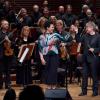When artists are famously temperamental, collaboration can be maddening — or magical.
The San Francisco Symphony’s concert on Thursday, Oct. 16 at Davies Symphony Hall, conducted by Jun Märkl and starring violinist Leonidas Kavakos, was both.
Judging by his penchant for musical excavation — including, famously, the premiere recording of the original version of Jean Sibelius’s violin concerto — Kavakos is a thoughtful musician. In the concert hall, though, his thinking can be difficult to follow, as his performance of Béla Bartók’s Violin Concerto No. 2 showed.
Bartók, contemplating the rise of fascism in 1930s Hungary, was not in the mood to write a concerto. But when a violinist friend came knocking, he reluctantly began a long exercise in musical diplomacy. The performer got his three movements and flashy ending. The composer got the last laugh: He twisted the traditional concerto structure into a colossal theme and variations, just the kind of movement he’d originally set out to write. With each turn of the theme, new colors and styles — ranging from 12-tone serialism to folk dance — converge like confetti in a kaleidoscope.
In the first of three performances, the slow movement was the most well-formed. The recitative passages, pale-toned and musing, were like reminiscences; the slurred runs positively glided. Such static playing, however, made the outer movements sound oddly one-dimensional. The music lost its heat and its humor. Often, Kavakos seemed lost in his own world.
Yet Märkl, who spent his early career conducting opera in his native Germany, made a remarkably effective liaison between Kavakos and the orchestra, which was in fine form, particularly in the pointillistic passages of the slow movement and the thorny rhythms of the finale.
At 66, Märkl is making his long-overdue debut with the San Francisco Symphony, and for these performances he dusted off Maurice Ravel’s 1912 ballet score Daphnis et Chloé. Minor obstacles — romantic rivals, abduction by pirates — beset the two shepherds at the center of this epic love story, a sensuous retelling of a Greek romance novel from the second century C.E. The rest is all supplication and swooning.
But Ravel had a more fraught relationship with the personnel of the Ballets Russes, including the domineering impresario Serge Diaghilev, who cut the chorus part and a choreographer who didn’t speak French. He called his Daphnis a “choreographic symphony.” Diaghilev’s dancers, trying to parse these pretty but sometimes featureless expanses of music, could barely keep a count.
The score is familiar territory for the Symphony, however. In recent seasons they’ve played various suites from it and two years ago, with former music director Esa-Pekka Salonen and the Symphony Chorus, they performed the entire 55-minute score. (For this run the orchestra played the full score without chorus.)
So it wasn’t a surprise, only a pleasure, to hear such nuanced solos. Clarinets Carey Bell and Steve Sánchez made the exotic lines in the Dance of Lycéion especially enticing. On English horn, Russ de Luna imbued Chloé’s pleading dance with a tragic grace. And principal flutist Yubeen Kim, whose appointment is perhaps the most auspicious development to have occurred since the Symphony’s last performance of this music, evoked the mellifluous melodies of Pan’s reed pipe with utmost subtlety, first with languor, then with verve.
Märkl drew many hues out of this orchestra: electric brass dissonances, hypnotic string trills, watercolor textures in Part I’s listing waltz. The sound was luxurious, the pacing just indulgent enough and always with a sense of line. The bacchanal finale, an orgy of chromaticism, shimmied ecstatically.
Of course, all the rest danced, too.




